Revealing the secrets of the interplanetary alien
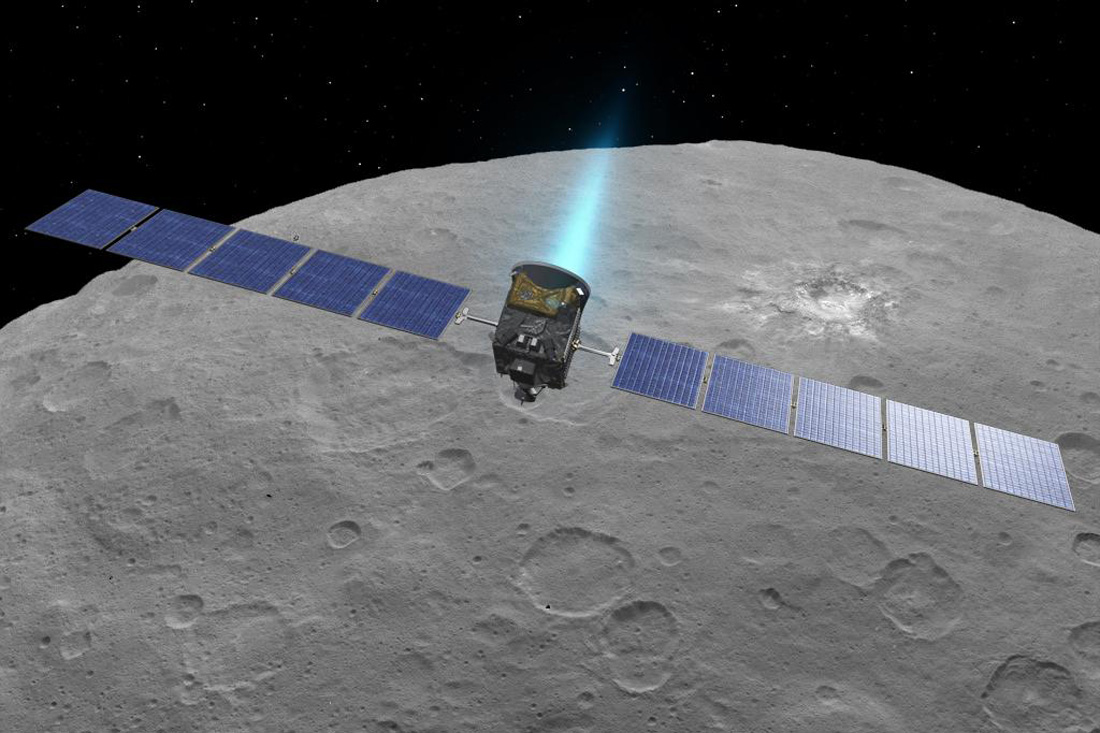
The dwarf planet Ceres is a rather unique and in many ways mysterious body, which has been closely studied by the NASA Dawn probe since spring 2015. Ceres revolves around the Sun roughly between Mars and Jupiter in the asteroid belt, but the scientific results of Dawn suggest that it arrived at the current “parking spot” from more distant edges.
Ceres was discovered more than 200 years ago, but for almost two centuries, people could not see anything except a dot or a small speck because of the imperfection of optics. The discovery of the Main Asteroid Belt began with Ceres, and because of their external resemblance to distant stars, the asteroids got their name - “star-like”. Their sizes are so small that telescopes of the past and the last century were not able to distinguish at least some details of the surface. At first, Ceres was considered a planet, but was quickly “degraded” into asteroids, and in this rank she spent two centuries. The discussion on the status of Pluto led to the clarification of the term “planet” and the introduction of the new term “dwarf planet”. In 2006, Ceres received the title of dwarf planet, and among them became the smallest and closest to Earth. By this time, the Hubble space telescope could see it better and show a spherical shape, thanks to which got this title. The diameter of Ceres is about 950 km, which is 3.5 times smaller than our Moon and 2.5 times smaller than the diameter of Pluto. Pluto's moon Charon is slightly larger than Ceres, but it flies around the Sun itself, so she deserves a special title.
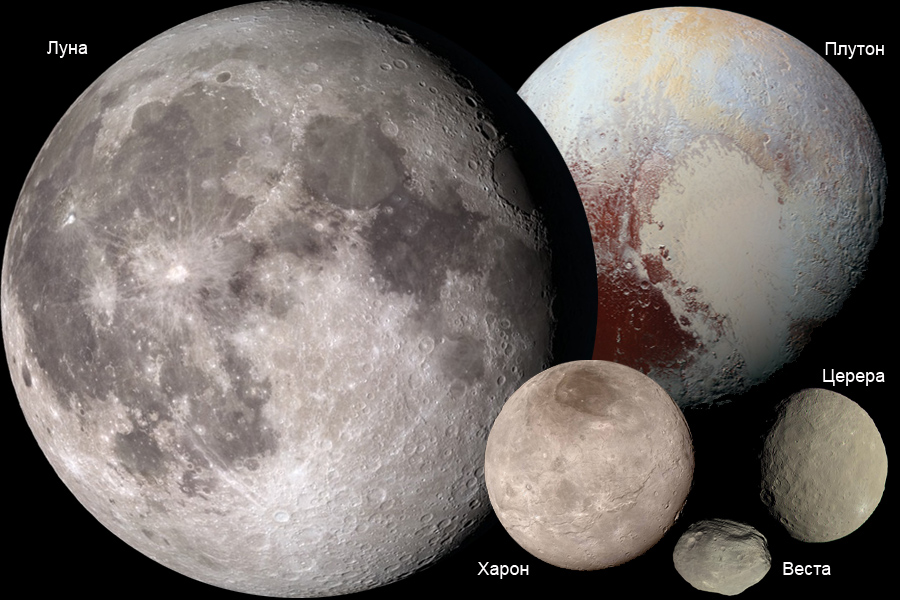
The remaining dwarf planets: Pluto, Eris, Haumea and Makemake rotate much further - beyond the orbit of Neptune. Of these, only Pluto was briefly visited by the New Horizons earth probe. In 2015, the interplanetary automatic station Dawn (“Dawn”) arrived at Ceres, in three years it changed several orbits of different heights: 5100-4400-1500-385-200 km, and now Ceres is the most studied dwarf planet.
Dawn is a classic probe for investigating atmosphereless bodies of the Solar System: a small panchromatic telescope with eight spectral filters on the wheel, an infrared spectrometer and a gamma-neutron spectrometer are located on board.
A special feature of Dawn's design is its propulsion system - it uses electric rocket ion engines. A feature of these engines is the high rate of outflow of jet gases, which allows you to spend the stock much more economically than the more common chemical engines. The disadvantage of ionics is the negligible amount of gas in the jet stream. Therefore, where the chemical engine will need to be turned on for a few minutes, the ion engine will have to work for tens of hours. In addition, electric rocket engines require a lot of energy, so Dawn is equipped with solar panels with a span of almost 20 meters.
Despite the shortcomings of the ionic engines, they allowed Dawn to make a long and multi-stage voyage in the asteroid belt and conduct a complex scientific program. Launched in 2007, Dawn arrived at the largest asteroid in the Main Belt between Mars and Jupiter-West. This egg-shaped rough stone body is about 550 km in size. If Vesta had a spherical shape like Ceres, it would also be called a dwarf planet.
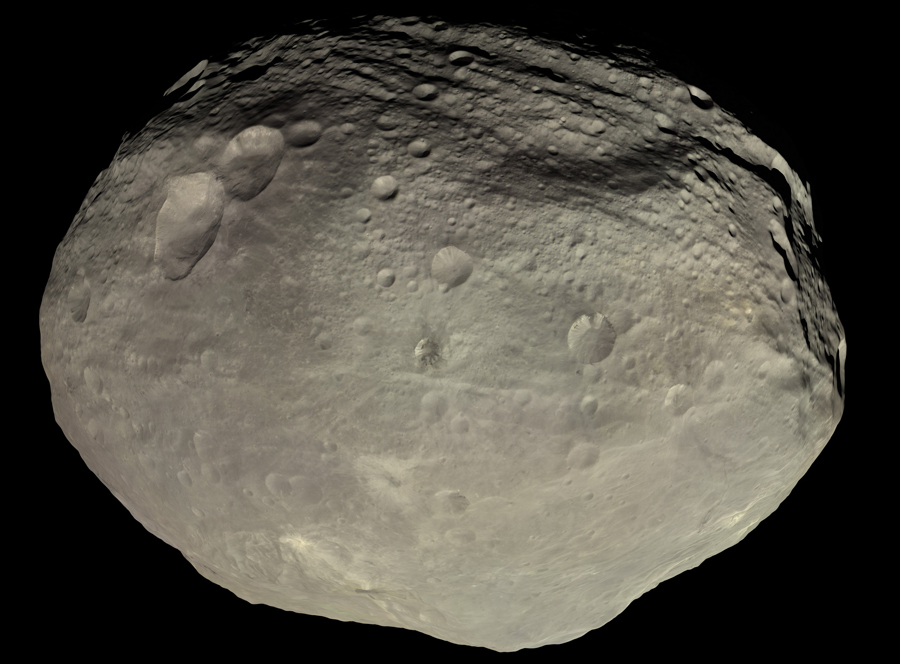
Dawn went into orbit around Vesta, and studied it for more than a year from three different orbits. Then the probe took advantage of the ion thrust, and returned to the interplanetary trajectory to get to the next important goal - the dwarf planet Ceres. The flight lasted two and a half years.
A curious fact: Dawn spent eight years in the asteroid belt and made three orbits around the Sun, but did not meet a single asteroid other than Vesta. This is a good example of how much asteroids fill the space in the thick of the Main Belt. If even one well-known asteroid got in the way, NASA would not miss the opportunity to study it at least from a distance and on a flying trajectory.
The rapprochement with Ceres in the winter of 2015 immediately began with intrigue - on the surface of a dark dwarf planet (slightly darker than the moon) several bright white spots were found concentrated on the bottom of one crater. Earlier, the ESA Herschel infrared space telescope detected the release of water vapor at an intensity of about 3 kg / s, but the scientists put forward the hypothesis of water ice carefully, considering other possibilities.

The water in Ceres did not surprise anyone, even earlier, the analysis of its orbital characteristics made it possible to calculate its mass, and after specifying the sizes, they obtained an average density of 2.1 g per cubic centimeters. This is very small compared to stone asteroids. For example, Vesta has a density of 3.4 g per cubic cm, and the most common basalt rock in the solar system has a density of about 2.6 g per cubic cm. Therefore, even before Dawn arrived, a high water content was assumed, up to 50% in the Ceres mantle. For comparison, meteorites arriving on Earth from Vesta contain no more than 0.04% of water.
The spherical shape of Ceres indicates a differentiation, i.e. separation into the stone core, possibly with an admixture of metals, and the stone-ice mantle. All this is covered with a thin layer of regolith accumulated over billions of years on the surface.
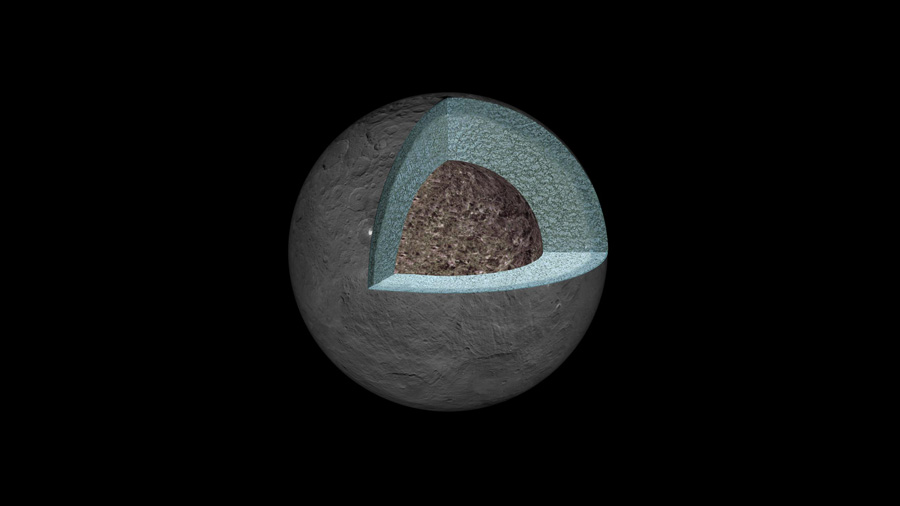
Dawn's discoveries began with bright spots in a crater called Occator, but this was only the beginning. Immediately noticed another noticeable feature - almost the right cone of the mountain, called Ahuna. It stood out against the background of the average “roughness” of the surface, rising to 5 km with a base of 20 km. Near the mountain is a deep meteor crater of about the same size, but probably they are not connected. But from the opposite side of the dwarf planet there is an ancient and the largest crater in Ceres from an asteroid 280 km in diameter. Perhaps Mount Akhuna is a volcano that formed at the focal point of seismic waves at the moment of impact from the reverse side. Similar processes could occur on Mercury (Plain of Heat), Mars (Highland Farsid and Elysian Highlands), Earth (Putoran Plateau). Evidence of volcanism on Mount Akhun was found using an infrared spectrometer — deposits of sodium carbonate were identified on the top and slopes. Most likely Akhuna is a cryovolcan, i.e. volcano spewing water with various impurities. Unfortunately, the mountain has no fresh traces of volcanism.

For two years, Dawn was able to identify many materials that indicated the past geological and chemical activity of liquid water in Ceres: there was clay, which is the result of water erosion of volcanic rocks, sodium carbonate, and its variant associated with water in the form of bicarbonate soda, too, found a lot. Organic compounds are responsible for a slight redness in emissions from some meteorite craters. Moreover, it turned out that the evolution of the surface is still ongoing: landslides are coming off the slopes of some craters, water evaporates from the sun-heated surface areas, creates a temporary atmosphere, and accumulates frost in the cold shade.
The brightest confirmation of the hydrothermal activity on Ceres were the brightest spots in the Okkator crater. The crater itself appeared about 80 million years ago, but the white sediments, which also turned out to be soda, are 30 million years younger. The most recent sediments are generally recent by geological standards - about 4 million years. In the center of the largest carbonate spot, too, the cryovolcanic dome rises, only much smaller than Akhuna.
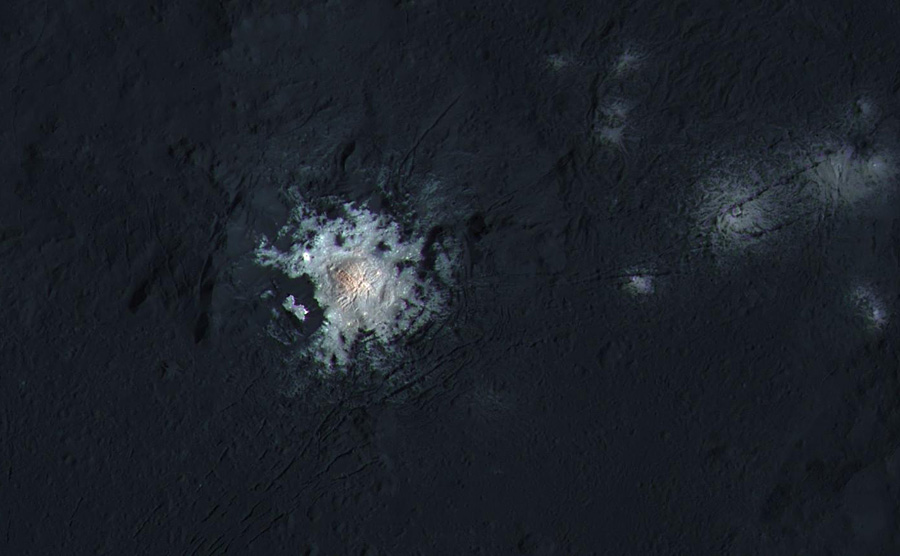
Another mystery threw a study of the gravitational field of Ceres. According to his results, the density of the upper layer of the dwarf planet is rather low - closer to the ice than to the stone. According to earlier studies, water should be 40-50% of the upper mantle. At the same time, the stability of large geological formations, such as Mount Akhun or many deep craters, is surprising. Normal permafrost would not hold such structures due to the plasticity of ice. It turns out something inside “holds the frame”. Scientists have suggested that clathrates, gas hydrates, are crystalline compounds of water and various gases, which are formed at a certain ratio of temperature and pressure, as the “armature” of the ice depths of Ceres. For example, methane hydrate from water and methane occurs at 0 degrees. Celsius at a pressure of 50 atm, as the temperature decreases, the required pressure decreases. Clathrates can be 100-1000 times stronger than ice, with the same density. That is, we have indirect evidence of volatile substances hidden in the depths of Ceres, which are no longer on the surface.
Another confirmation of the past degassing of Ceres is the discovered chains of small craters 1-4 km wide, up to 500 km long. Presumably they arose in regolith over cracks in the crust of a dwarf planet. Cracks can have a different origin: from tectonics, from a powerful asteroid impact, from a change in the volume of a cosmic body due to its cooling ... But each of these causes has certain signs that are not on Ceres. Degassing was the most convincing hypothesis, when gas streams from internal reservoirs emerged out of the crust through the cracks.
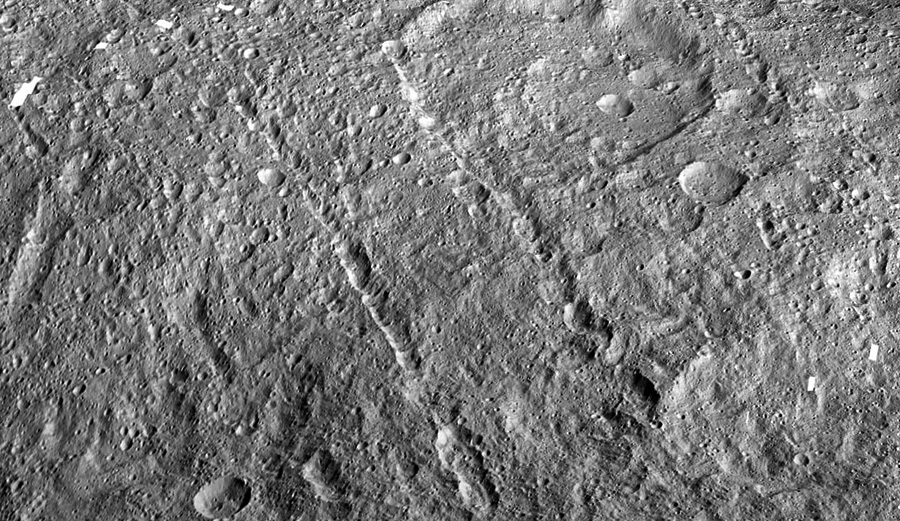
The most intriguing discovery on Ceres was ammonia found on the surface with carbonates and clays. Ammonia dissolved in water lowers its freezing point, which allows cryovolcanes to erupt even at sub-zero temperatures. Ammonia is interesting primarily because it indicates the origin of Ceres somewhere outside its current orbit, i.e. she is an alien in the main asteroid belt.
This conclusion follows from the so-called. “Snow line” (frost line) - distance from the Sun, where heat is not enough to maintain the gaseous form, which leads to the condensation of gas into a solid form. At the time of the formation of the Solar System, the snow line for water was located at a distance of about 420 million km from the Sun, i.e. about where Ceres rotates. Now the waterline of the snow line is located even further - about 750 million km from the Sun - almost at the orbit of Jupiter. Closer than this distance, only stone planets, satellites and asteroids rotate, on which there can be ice only at the poles, or in the shade, or under the surface. On the terrestrial mountain tops the ice is held due to atmospheric pressure. Beyond the waterline of the snow line, ice comets fly in abundance, and the satellites of the planets almost either consist of ice or are all covered with ice.
Unlike water, ammonia has a lower condensation temperature, and during the formation of the solar system, its snow line lay about 80 million km farther than the orbit of Ceres, i.e. He could not take part in its creation. There are other indirect signs that Ceres is a guest in the Main Belt. As already mentioned, the water in the dwarf planet is incomparably more than in the asteroids in the neighborhood. Exceptions are only in "degenerated" comets, and distant asteroids at the orbit of Jupiter. Practically all large asteroids of the Main Belt have their own families, i.e. groups of small asteroids that have common spectral characteristics and similar orbits, while Ceres does not.
In general, it should be recognized that Ceres is more similar in form and composition to the large satellites of Jupiter or even to other dwarf planets, like Pluto. Saturn's spherical satellites are generally less dense than Ceres, due to the higher ice content. Pluto is denser than ice satellites, but it does not reach Ceres, but it could gain density by “dumping” light gases, after approaching the Sun. The inclination of the Ceres orbit suggests that it did not come from Jupiter, so maybe it was once a dwarf planet on the outskirts of the Solar System. Perhaps a more detailed study will give answers.
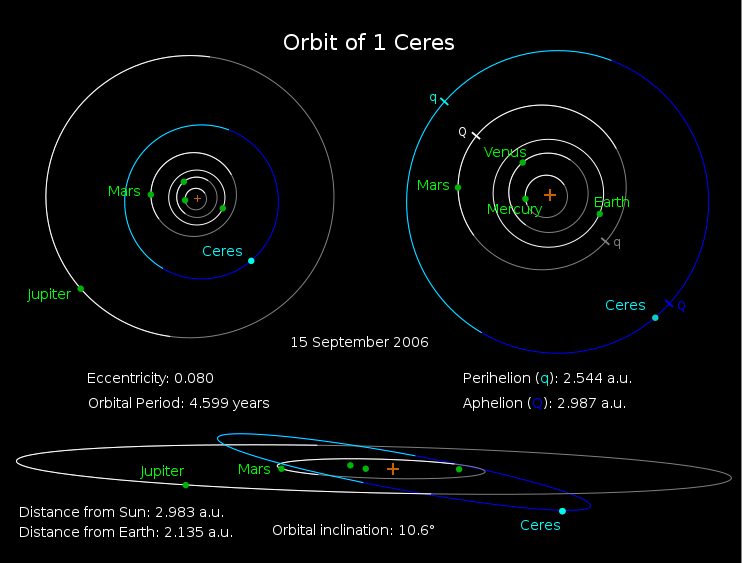
Dawn is now preparing to go to the lowest final 50 km orbit, this promises new surface details and new discoveries. Although in the future it would be worthwhile to launch a landing probe there. Already perfect discoveries are enough to understand its high value for the study of the history and evolution of the solar system.
